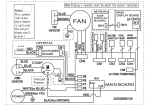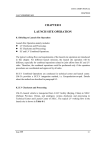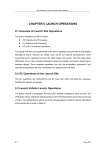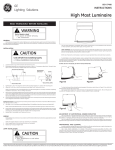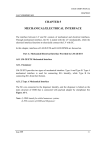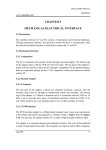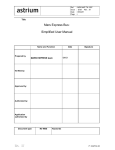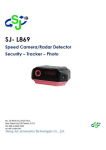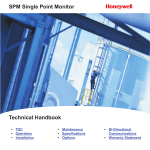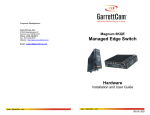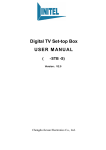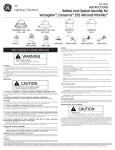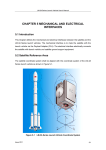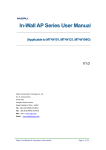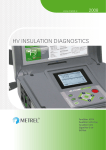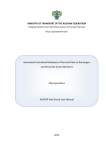Download Chapter 8 Launch Operations
Transcript
LM-2E USER’S MANUAL CHAPTER 8 CALT'S PROPRIETARY CHAPTER 8 LAUNCH SITE OPERATION Launch Site Operation mainly includes: z LV Checkouts and Processing; z SC Checkouts and Processing; z SC and LV Combined Operations. The typical working flow and requirements of the launch site operation are introduced in this chapter. For different launch missions, the launch site operation will be different, especially for combined operations related to joint efforts from SC and LV sides. Therefore, the combined operations could be performed only if the operation procedures are coordinated and approved by all sides. LM-2E uses JSLC and XSLC as its launch sites. The launch site operations in the two launch sites are described as follows. Part A: Launch Operations in JSLC Two-stage LM-2E and LM-2E/ETS are launched from in JSLC. A8.1 LV Checkouts and Processing Two-stage LM-2E or LM-2E/ETS launch vehicle is transported from CALT facility (Beijing, China) to JSLC (Gansu Province, China), and undergoes various checkouts and processing in South Technical Center and South Launch Center of JSLC. The typical LV working flow in the launch site is shown in Figure A8-1. Issue 1999 8-1 LM-2E USER’S MANUAL CALT'S PROPRIETARY CHAPTER 8 Day 1 2 3 4 5 6 7 8 9 10 11 12 13 14 15 Figure A8-1 LV Working Flow in JSLC 16 18 19 In Technical Center 17 20 21 23 24 In Launch Center 22 8-2 8-2 Issue 1999 LM-2E USER’S MANUAL CHAPTER 8 CALT'S PROPRIETARY A8.2 Combined Operation Procedures Take LM-2E/ETS launching multiple SCs as an example: A8.2.1 SC Integration and Fairing Encapsulation in South Technical Center In BS3, SC team carries out all the SC operations. LV side is responsible for mating SCs with dispenser and installing SC separation devices. The following describes the typical working procedure: 1. CALT to bolt the dispenser on the supporting table; 2. SC team to lift up SCs, and CALT to mate them with dispenser one by one and install SC/LV separation devices; 3. CALT to complete the SC/LV integration and form a SC/Dispenser stack; 4. CALT to mate OMS with payload adapter in BLS and to transfer the OMS/Adapter stack from BLS to BS3; CALT to set up the fairing encapsulation pad in BS3. 5. CALT to bolt the OMS/Adapter stack on the fairing encapsulation pad; 6. CALT to integrate the SC/Dispenser stack with OMS/Adapter stack. See Figure A8-2. 7. CALT to encapsulate the fairing in BS3; 8. CALT to remove the fairing fixture, and to install the hoisting basket; See Figure A8-3. Issue 1999 8-3 LM-2E USER’S MANUAL CALT'S PROPRIETARY CHAPTER 8 1. To bolt the dispenser on supporting table. 2. To mate the spacecraft with the dispenser one by one. 4. To transfer the OMS/Adapter stack from BLS to BS3, and to set up the fairing encapsulation pad. In BS3 3. To complete the integration and form a SC/Dispenser stack. 5. To bolt the OMS/Adapter stack on the pad. Figure A8-2 Payload/LV Integration Payload Adapter Supporting Table a). To bolt Payload Adapter on a supporting table. In BLS b). To mate the OMS with Payload Adapter, and form a OMS/Adapter stack 6. To integrate the SC/Dispenser stack with OMS/Adapter stack. 8-4 8-4 Issue 1999 LM-2E USER’S MANUAL CALT'S PROPRIETARY CHAPTER 8 Hoisting Basket 7. To encapsulate the fairing. 8. To remove the fairing fixture, and to install the hoisting basket. Figure A8-3 Fairing Encapsulation in BS3 8-5 8-5 Issue 1999 LM-2E USER’S MANUAL CHAPTER 8 CALT'S PROPRIETARY A8.2.2 SC Transfer and Fairing/Stage-2 Integration CLTC is responsible for transferring the encapsulated fairing from BS3 to BLS. The following working procedures are performed: 9. CLTC to lift the encapsulated fairing onto the transfer vehicle and to fasten the fairing with ropes; CLTC to drive the vehicle from BS3 to BLS; 10.CLTC to release the encapsulated fairing from the transfer vehicle; CLTC to install hoisting slings to the encapsulated fairing inside BLS; 11.CLTC to lift the fairing onto the second stage of LM-2E, which is already erected; 12. CALT to mate the encapsulated fairing with stage-2 of LM-2E. This is the end of the combined operations. See Figure A8-4. After the above-mentioned combined operation is all over, LM-2E carrying SCs will undergo various functional checkouts inside BLS, then it will be transferred to launch center by moveable launch pad. A8.3 SC Preparation and Checkouts z CALT and CLTC are responsible for checking and verifying the umbilical cables and RF links. If necessary, SC team could witness the operation. z LV accessibility and RF silence time restriction must be considered, when SC team performs operation to SCs. Issue 1999 8-6 LM-2E USER’S MANUAL CALT'S PROPRIETARY CHAPTER 8 9. To lift the encapsulated fairing stack onto the transfer vehicle, and to drive the vehicle from BS3 to BLS. 11. To lift up the encapsulated fairing onto the LM-2E. 10. To move the encapsulated fairing stack into BLS and install hoisting sling. 12. To mate the encapsulated fairing with stage-2 of LM-2E. Figure A8-4 Payload Transfer and Fairing/stage-2 integration 8-7 8-7 Issue 1999 LM-2E USER’S MANUAL CHAPTER 8 CALT'S PROPRIETARY A8.4 Launch Limitation A8.4.1 Weather Limitation z z z z z z Ambient temperature: -10°C~+40°C; Relative humidity: ≤98% (corresponding to 20±5°C) The average ground wind velocity in the launch area is lower than 10m/s The winds aloft limitation: q×α≤3400N/m2•rad (q×α reflects the aerodynamic loads acting on the LV, whereas, q is the dynamic head, and α is LV angle of attack.) The horizontal visibility in the launch area is farther than 20km. No thunder and lightning in the range of 40km around the launch area, the atmosphere electrical field strength is weaker than 10kV/m. A8.4.2 "GO" Criteria for Launch z z z z The SCs' status is normal, and ready for launch. The launch vehicle is normal, and ready for launch. All the ground support equipment is ready; All the people withdraw to the safe area. A8.5 Pre-launch Countdown Procedure The typical pre-launch countdown procedure in the launch day is listed below: No. 1 2 3 4 5 Time -6 hours -5 hours -4 hours -2 hours -80 minutes 6 -60 minutes 7 8 -50 minutes -40 minutes Issue 1999 Event Preliminary Calculation by Flight Software Functional Checkouts on Each Sub-system GSE Withdrawal, LV Status Checkouts, Sealing Preparing to Move Back the Service Tower Moving Back the Service Tower; Accurately aiming; Ground Telemetry and Tracking Systems Power-on; Preliminarily Loading Flight Software; Loading PUS Software; Tank Pressurization Gas Pipes and Air-conditioning Pipes Drop-off; Flight Software Loading; SC Power Switch-over; 8-8 LM-2E USER’S MANUAL CHAPTER 8 CALT'S PROPRIETARY 9 -5 minutes 10 -60 seconds 11 12 13 -30 seconds -7 seconds 0 seconds On-board Telemetry and Tracking Systems Power-on Telemetry, Tracking and Propellant Utilization Systems Power Switch-over; Control System Power Switch-over; Control System, Telemetry System and Tracking System Umbilical Disconnection; Moving Back the Cable Swing Arms; TT&C Systems Starting; Camera on; Ignition. A8.6 Post-launch Activities The orbital parameters of the injected orbit will be provided to Customer in half-hours after SC injection. The launch evaluation report will be provided to the Customer in a month after launch. Issue 1999 8-9 LM-2E USER’S MANUAL CHAPTER 8 CALT'S PROPRIETARY Part B: Launch Operations in XSLC Two-stage LM-2E and LM-2E/EPKM are launched from XSLC. B8.1 LV Checkouts and Processing The launch vehicle is transported from CALT facility (Beijing, China) to XSLC (Sichuan Province, China), and undergoes various checkouts and processing in Technical Center and Launch Center of XSLC. The typical LV working flow in the launch site is shown in Table 8-1. Table 8-1 LV Working Flow in the Launch Site No. Item Working Accumulative Period Period 1 To Unload LV from the Train and Transfer LV to BL1. 1 day 1 day 2 Unit Tests of Electrical System 7 days 8 days 3 Tests to Separate Subsystems 3 days 11 days 4 Matching Test Among Subsystems 4 days 15 days 5 Three Overall Checkouts 4 days 19 days 6 Review on Checkout Results 1 day 20 days 7 LV Status Recovery before Transfer 2 days 22 days 8 To Transfer LV to Launch Center 1 days 23 days L 9 Erecting LV on the Launch Pad 2 days 25 days A 10 Tests to Separate Subsystems 3 days 28 days U 11 Matching Test Among Subsystems 3 days 31 days N 12 The first and second overall checkouts 2 days 33 days C 13 To Transfer SC/Fairing Stack to Launch Center 1 days 34 days H 14 EMC Testing 1 days 35 days 15 The Third Overall Checkout (SC Involved) 1 day 36 days C 16 The Fourth Overall Checkout 1 day 37 days E 17 Review on Checkout Results 1 day 38 days N 18 Functional Check before Fueling, Gas Replacement of Tanks 2 days 40 days T 19 N2O4/UDMH Fueling Preparation 1 days 41 days E 20 N2O4/UDMH Fueling 0.5 day 41.5 days 21 Launch 0.5 days 42 days 42 days 42 days T E C H . R Total Issue 1999 8-10 LM-2E USER’S MANUAL CHAPTER 8 CALT'S PROPRIETARY After the SC is transferred to Launch Center, some of SC and LV operations can be performed in parallel under conditions of no interference. B8.2 Combined Operation Procedures Take LM-2E/EPKM launching GTO satellite as an example. B8.2.1 SC Integration and Fairing Encapsulation in Technical Center In BS3, SC team carries out all the SC operations. CALT is responsible for mating SC with EPKM and installing the separation devices. The following describes the working procedure: 1. CALT to bolt the LV adapter on the fairing encapsulation pad; 2. CALT to mate the interface adapter with LV adapter, and install clampband system; 3. CALT to bolt EPKM with interface adapter; 4. SC team to install SC adapter on the SC; 5. SC team to lift up SC and move SC onto the EPKM; 6. CALT to bolt SC adapter with EPKM; 7. CALT to encapsulate the fairing in BS3; 8. CALT to remove the fairing fixture, and to install the hoisting basket; B8.2.2 SC Transfer CLTC is responsible for transferring the encapsulated fairing from BS3 to Launch Center. The following working procedures are performed: 9. CLTC to lift the encapsulated fairing onto the special vehicle and to fasten the fairing with ropes; CLTC to connect the air-conditioning to the fairing if necessary; CLTC to drive the vehicle from BS3 to Launch Service Tower; 10. CLTC to release the encapsulated fairing from the transfer vehicle; CLTC to install slings to the encapsulated fairing under the Launch Service Tower; CLTC to lift the fairing onto the 8th floor of the tower; Issue 1999 8-11 LM-2E USER’S MANUAL CHAPTER 8 CALT'S PROPRIETARY B8.2.3 SC/LV Integration in Launch Center The encapsulated fairing will be mated with the LV second stage on the service tower. The following working procedures are performed: 11. CALT to hoist the encapsulated fairing above the LV second stage; 12. CALT to joint the bottom of the fairing with LV second stage; CLTC to remove the hoisting basket outside the fairing; CLTC to connect the SC umbilical connectors and SC air-conditioning. B8.3 SC Preparation and Checkouts z CALT and CLTC are responsible for checking and verifying the umbilical cables and RF links. If necessary, SC team could witness the operation. z LV accessibility and RF silence time restriction must be considered, when SC team performs operation to SC. B8.4 Launch Limitation B8.4.1 Weather Limitation z z z z z z Ambient temperature: -10°C~+40°C; Relative humidity: ≤98% (corresponding to 20±5°C) The average ground wind velocity in the launch area is lower than 10m/s The winds aloft limitation: q×α≤3400N/m2•rad (q×α reflects the aerodynamic loads acting on the LV, whereas, q is the dynamic head, and α is LV angle of attack.) The horizontal visibility in the launch area is farther than 20km. No thunder and lightning in the range of 40km around the launch area, the atmosphere electrical field strength is weaker than 10kV/m. B8.4.2 "GO" Criteria for Launch z z z z The SC’s status is normal, and ready for launch. The launch vehicle is normal, and ready for launch. All the ground support equipment is ready; All the people withdraw to the safe area. Issue 1999 8-12 LM-2E USER’S MANUAL CHAPTER 8 CALT'S PROPRIETARY B8.5 Pre-launch Countdown Procedure The typical pre-launch countdown procedure in the launch day is listed below: No. Time Event 1 -6 hours Preliminary Calculation by Flight Software 2 -5 hours Functional Checkouts on Each Sub-system 3 -4 hours GSE Withdrawal, LV Status Checkouts, Sealing 4 -2 hours Preparing to Move Back the Service Tower 5 -80 minutes Moving Away the Service Tower; Accurately aiming; Ground Telemetry and Tracking Systems Power-on; 6 -60 minutes Preliminarily Loading Flight Software; Loading PUS Software; 7 -50 minutes Tank Pressurization 8 -40 minutes Gas Pipes and Air-conditioning Pipes Drop-off; Flight Software Loading; SC Power Switch-over; On-board Telemetry and Tracking Systems Power-on 9 -5 minutes Telemetry, Tracking and Propellant Utilization Systems Power Switch-over; 10 -60 seconds Control System Power Switch-over; Control System, Telemetry System and Tracking System Umbilical Disconnection; Moving Back the Cable Swing Arms; 11 -30 seconds TT&C Systems Starting; 12 -7 seconds Camera on; 13 0 seconds Ignition. B8.6 Post-launch Activities The injection parameters will be provided to Customer in half-hours. The launch evaluation report will be provided to the Customer in a month after launch. Issue 1999 8-13













